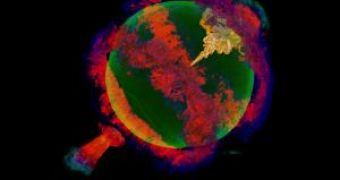A white dwarf is what stars like our Sun become after they have exhausted their nuclear fuel. Near the end of its nuclear burning stage, such a star expels most of its outer material, creating a planetary nebula. Only the hot core of the star remains. This core becomes a very hot (T > 100,000K) young white dwarf, which cools down over the course of the next billion years or so.
To say that white dwarfs are strange is an understatement. An earth-sized white dwarf has a density of 1 million tons per cubic meter. In comparison, the earth itself has an average density of only 5.4 tons per cubic meter. That means a white dwarf is 200,000 times as dense, so white dwarf stars have one and a half times the mass of the sun into an object the size of Earth.
When they burn out, the ensuing explosion produces a type of supernova that astrophysicists believe manufactures most of the iron in the universe. But these type Ia supernovas, as they are called, may also help illuminate the mystery of dark energy, an unknown force that dominates the universe.
Blowing up a white dwarf star by writing the laws of physics into computer software and then testing it in simulations has been attempted by scientists for years.
The Flash Center has been simulating exploding stars since 1997 with funding from the Office of Advanced Simulation and Computing of the National Nuclear Security Administration, but in January, the Flash Center team, for the first time, naturally detonated a white dwarf in a more realistic three-dimensional simulation that confirmed what the team already suspected from previous tests: the stars detonate in a supersonic process resembling diesel-engine combustion.
The temperatures attained by a detonating white dwarf star makes the 10,000-degree surface of the sun seem like a cold winter day in Chicago by comparison. "In nuclear explosions, you deal with temperatures on the order of a billion degrees," said Flash Center Research Associate Cal Jordan.
The new 3D white dwarf simulation shows the formation of a flame bubble near the center of the star. The bubble, initially measuring approximately 10 miles in diameter, rises more than 1,200 miles to the surface of the star in one second. In another second, the flame crashes into itself on the opposite end of the star, triggering a detonation. "It seems that the dynamics of the collision is what creates a localized compression region where the detonation will manifest," Townsley said.
The scientific payoff for logging these long, stressful hours is potentially huge. Astrophysicists value type Ia supernovas because they all seem to explode with approximately the same intensity. Calibrating these explosions according to their distance reveals how fast the universe has been expanding at various times during its long history.

 14 DAY TRIAL //
14 DAY TRIAL //